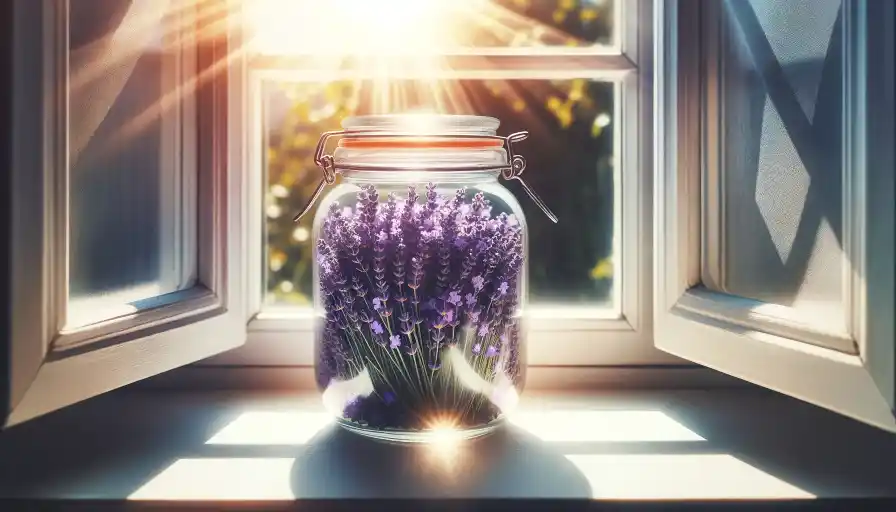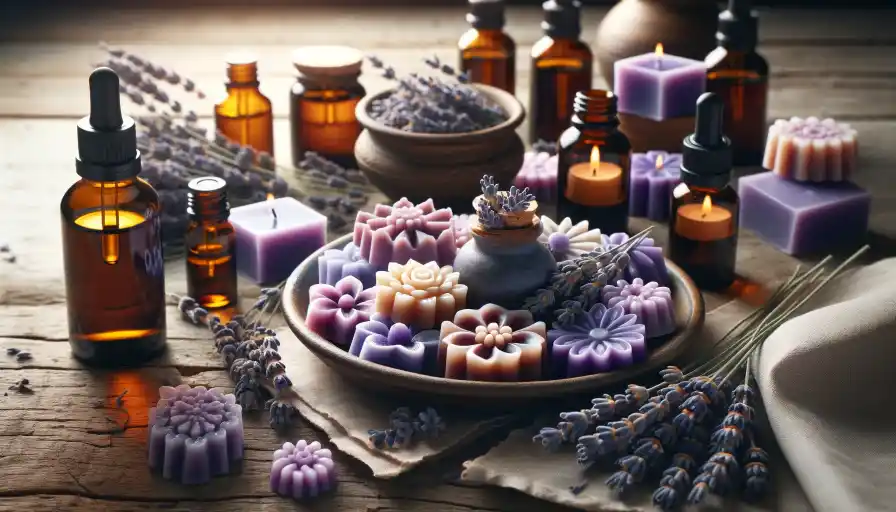Forget Store-Bought: Make Lavender Oil that Rivals the Best
Making lavender oil at home is simple and can often surpass the quality of commercial products.
This guide teaches how to grow, harvest, and process garden lavender for the best oil yield. You’ll discover techniques to make high-grade lavender oil better than store versions.
Making your own lavender oil also means you can customize it and avoid unwanted ingredients. This guide will teach you to make premium lavender oil easily with basic ingredients and methods.
Let’s get started!
Read: 5 Lavender Oils Aromatherapy Benefits
Growing Lavender for High Quality Oil
The first step in achieving top-shelf lavender oil is growing excellent lavender. Here are some tips:
Choose the Right Variety
Opt for types known for their fragrant oil like English lavender (Lavandula angustifolia) or French lavender (Lavandula dentata). Avoid lavandin which has a weaker aroma.
Give it Full Sun and Well-drained Soil
Lavender thrives on 8+ hours of direct sunlight daily and soil that drains well to avoid root rot.
Prune Regularly
Pruning encourages bushy growth and more flower spikes. Do it in spring and again after flowering.
Harvest at the Right Time
Cut flowers when they just start to open, in the morning after the dew dries. Oils are most abundant then.
Growing quality lavender is the first step to DIY lavender oil success! Now let’s get into the oil-making process…
How to Make Lavender Oil at Home
Follow these simple steps to extract those precious oils from your homegrown lavender:
1. Harvest and Dry the Flowers
Cut flowers when the bottom-most buds on the spike begin to open. Bundle 10-15 stems and hang upside down in a warm, well-ventilated area until crispy dry – up to a month.

2. Add to a Jar with Your Oil of Choice
Place freshly dried flowers (old ones lose potency) in a sterilized jar, packing down well. Pack jar tightly so flowers are compressed. Then pour oil over the flowers until they’re fully submerged. I like using olive, grapeseed, or coconut oil.
3. Infuse in a Sunny Spot
Tightly seal the jar and place it on sunniest window you have for 6 weeks, shaking vigorously daily. The warmth and light help extract the oils. Infuse at room temperature if possible and keep away from heat/AC vents or drafts.

4. Strain and Store
Pour through a cheesecloth to remove the lavender. Pour through a fine mesh strainer or coffee filter to remove all bits.Transfer the finished oil into containers and store in a cool, dark cupboard.
And that’s all it takes! Now let’s look at some pro tips for taking your homemade lavender oil to the next level.
Creative Uses for DIY Lavender Oil
The uses for homemade lavender oil are unlimited. Here are some of my favorites:
- Add a few drops to bath water for an aromatherapy soak
- Dab on temples and wrists before bedtime to promote sleep
- Make a surface spray by combining with water in a spritz bottle
- Add to lemonade or ice cream for a floral flavor boost
- Blend with coconut or olive oil for a soothing lotion
- Place a drop on pillows and bedsheets for a calming scent
You can also add lavender oil to homemade soaps, salves, linen sprays, and more. The options are endless!
Now that we’ve covered all the steps to make lavender oil and fun ways to use it, let’s look at why making your own is so worthwhile.
The Benefits of Homemade Lavender Oil
There are many advantages to crafting your own lavender oil rather than buying it:
Total Control Over Quality
You choose the variety, growing conditions, harvest timing and extraction process – everything that determines quality.
Ability to Customize
Experiment with different carrier oils, infusion times, etc. to create your ideal lavender oil.
Avoid Unwanted Ingredients
No hidden preservatives, emulsifiers, fragrances, etc. that commercial oils often contain.
Lower Cost in the Long Run
More affordable than constantly buying 1-2 ounce bottles from the store.
Makes Thoughtful Handmade Gifts
Infuse lavender from your garden into oil as a heartfelt present for friends and family.
As you can see, do-it-yourself lavender oil lets you control every aspect of the process so you get an oil that’s exactly what you want.
Next let’s look at the essential supplies you’ll need to embark on making your own.

Helpful Supplies for DIY Lavender Oil
While the ingredient list for lavender oil is short, having the right supplies on hand makes the process easier. Here are some must-haves:
- Glass jars – for infusing and storing oil. Go with dark ones if possible to limit light exposure.
- Cheesecloth – also called muslin, this finely woven cotton is ideal for straining herbs from finished oils. Pours through smoothly while catching all debris.
- Kitchen funnel – makes transferring finished oil from one container to another mess-free. Look for a wide-mouth funnel that fits your jars.
- Mason jars – classic for infusing and the perfect size for gifting homemade oil. Their leak-proof lids lock in scent.
- Fine mesh strainer – an additional filtering step to ensure no particles end up in your final oil.
- Dropper bottles – convenient for storing and dispensing smaller amounts of oil. Protects from light and air.
With these simple items, you’ll be ready to start producing spa-quality lavender oil in your own kitchen.
Now for the fun part – let’s look at some popular varieties of lavender you can use!
Top Types of Lavender for Oil Making
There are over 400 varieties of lavender, but some are better suited for oil production than others. Here are top types to try:
English Lavender
This hardy heirloom has a sweet, floral aroma perfect for perfumes and body products. It’s the most popular for oil.
French Lavender
Grown for the perfume industry, it has a rich, complex scent featuring citrusy and spicy notes.
Spanish Lavender
Offers an intense lavender aroma with hints of camphor and eucalyptus. The oils have antiseptic properties.
Portuguese Lavender
Produces abundant oil with sharper herbal notes than English varieties. The scent is invigorating.
Grosso Lavender
A hybrid crossbred for essential oil production, it yields plentiful aromatic oils on compact 18-inch plants.
The takeaway is to sample different lavenders and choose the one with the scent profile you find most appealing. Now let’s examine the pros and cons of crafting your own oil.
Pros and Cons of Homemade Lavender Oil
Like any DIY project, making your own lavender oil comes with both advantages and potential drawbacks depending on your goals:
Pros
- Total control over the end product
- Ability to customize scent and texture
- Satisfaction of growing and handcrafting something yourself
- Lower cost than buying pre-made oil
- Makes wonderful handmade gifts
Cons
- Requires an upfront investment in plants/supplies
- Labor intensive harvesting and processing
- Learning curve to achieve optimal quality
- Yields smaller batches than commercial production
As you can see, the pros generally outweigh the cons, especially if you enjoy gardening and handcrafting. The initial effort pays off in having an abundant supply of your own signature lavender oil.
Now that you know how to make high-quality lavender oil at home, let’s recap the key steps:
Mastering DIY Lavender Oil: A Recap
Follow this checklist for crafting top-notch homemade lavender oil:
- Start with excellent dried lavender flowers
- Use a quality carrier oil like olive, grapeseed or coconut
- Pack flowers tightly into a sterile glass jar
- Completely cover with oil and seal tightly
- Place in a warm sunny spot and shake jar daily
- Infuse for 2-6 weeks until fragrant
- Strain through cheesecloth and a fine mesh sieve
- Transfer to storage containers out of direct light
And that’s all you need for homemade lavender oil that rivals the quality of anything from the store!
The investment of time and care is well worth it to be able to craft and customize your own oil. I hope this guide inspires you get growing and start infusing your own lavender oil at home. Make Lavender Oil that Rivals the Best

